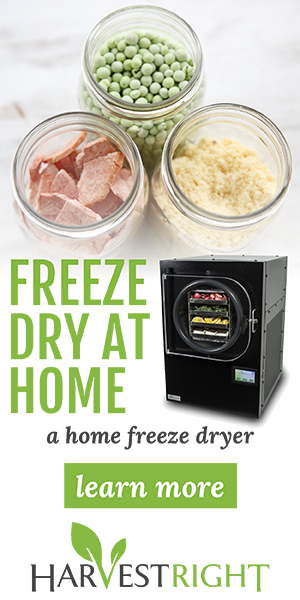Cooking with Freeze-Dried Foods
Cooking with freeze-dried foods is a culinary journey filled with convenience, flavor, and nutritional benefits. Whether you're a busy home chef looking to save time, a health-conscious individual seeking nutrient-dense meals, or simply someone who loves exploring new culinary horizons, freeze-dried foods have something to offer. In this article, we'll delve into the advantages of cooking with freeze-dried ingredients and explore creative ways to incorporate them into your meals.
Advantages of Cooking with Freeze-Dried Foods
No Prep Required
One of the most significant advantages of using freeze-dried ingredients is that they come ready to use. Unlike fresh produce, there's no need for washing, peeling, dicing, slicing, or chopping. This time-saving aspect makes cooking with freeze-dried foods a breeze, especially on busy days when you want to prepare a quick and delicious meal.
Concentrated Flavor with No Excess Moisture
Freeze-drying removes approximately 97 percent of the moisture from food, resulting in a concentrated, rich flavor that's sure to excite your taste buds. Unlike fresh or canned ingredients, freeze-dried foods won't dilute your sauces, stews, broths, or soups with excess liquid, ensuring your dishes maintain their intended consistency and taste.
All-Natural, Nutrient-Dense Ingredients
Freeze-dried foods are made from natural ingredients without additives, dyes, preservatives, sulfites, or other chemicals commonly found in store-bought products. This means you have complete control over what goes into your meal, ensuring a natural and nutritious dining experience.
Fast, Delicious, and Easy Meals
Cooking with freeze-dried ingredients allows you to whip up quick and easy meals packed with flavor and nutrition. Their lightweight nature and lack of refrigeration requirements make them ideal for various cooking scenarios, from weeknight dinners to camping trips.
Incorporating Freeze-Dried Foods into Your Diet
Now that you know the benefits of using freeze-dried ingredients, let's explore how to seamlessly integrate them into your meals. The versatility of freeze-dried foods opens up a world of possibilities for enhancing your dishes.
Crumbling Freeze-Dried Ingredients for Decoration and Flavor
Freeze-dried ingredients can be crumbled to not only add flavor and nutrition to your dishes but also provide a decorative touch. For example, try sprinkling crumbled freeze-dried strawberries on top of cheesecake for a delightful burst of color and flavor. Additionally, you can use powdered freeze-dried vegetables and fruits, like beet powder, carrot powder, or spinach powder, to enhance the visual appeal of your creations.
Adding Freeze-Dried Powders as Ingredients, Flavorings, or Nutrient Boosts
Powdered freeze-dried ingredients offer a myriad of culinary possibilities. You can incorporate them into your meals as ingredients, flavorings, or nutrient boosts. Here are some creative ideas:
- Smoothies: Add powdered fruits and vegetables to your smoothies for an extra dose of nutrition and flavor. They blend seamlessly with other ingredients, enhancing the overall taste and health benefits of your smoothie.
- Baking: Incorporate powdered freeze-dried ingredients into your baked goods, such as muffins, pancakes, cupcakes, burgers, lasagna, and dips. Unlike fresh counterparts, powdered ingredients won't introduce unnecessary moisture to batters and doughs, ensuring perfect texture.
- Sauces: Create delicious, smooth sauces by adding freeze-dried powders. You'll typically need less water to reconstitute a powder than was removed during the freeze-drying process, resulting in a concentrated and flavorful sauce.
Adding Freeze-Dried Ingredients Directly to Soups
When preparing soups or other liquid-based recipes, you can toss freeze-dried ingredients directly into the pot. These dishes provide sufficient moisture to rehydrate the freeze-dried components, making them a convenient addition. If your recipe requires a watery sauce, like spaghetti sauce, simply add 1-2 tablespoons of water for every half cup of freeze-dried ingredients. This allows you to incorporate freeze-dried ingredients just as you would fresh counterparts. However, for thick sauces like creamy white sauce, it's advisable to rehydrate the ingredients before adding them to the sauce.
Adding Freeze-Dried Fruits and Vegetables to Blender Drinks
Smoothies and shakes are excellent vehicles for integrating freeze-dried fruits and vegetables into your diet. The best part is that freeze-dried ingredients don't require rehydration when making these healthful beverages. Simply combine them in a blender with your choice of liquid, such as water, juice, almond milk, or yogurt. You can experiment with various combinations to create delicious and nutrient-packed drinks.
Sautéing Freeze-Dried Ingredients Prior to Use
Depending on the type of dish you're preparing, freeze-dried ingredients may not necessitate rehydration before cooking. For recipes that involve sautéing ingredients like peppers, onions, or meat, you can save time by adding dry freeze-dried components directly to the pan. Sautéing time is significantly reduced, and there's no need to rehydrate beforehand. Only introduce water if the recipe specifically calls for it or to prevent overcooking.
Cooking with freeze-dried ingredients offers a host of benefits, from time savings to concentrated flavor and enhanced nutrition. These versatile ingredients can be seamlessly incorporated into various recipes, allowing you to experiment with new flavors and textures while simplifying your cooking process. Whether you're crumbing freeze-dried ingredients for decoration, adding powders for flavor, or tossing them into soups, freeze-dried foods open up a world of culinary possibilities.
Recommended Articles:
Cooking with Freeze-Dried Foods

